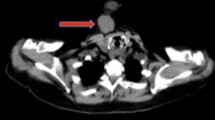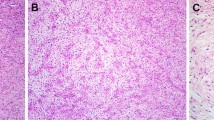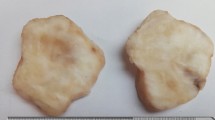Abstract
Background
Fibromatosis is an aggressive fibrous tumor of unknown etiology that is, in some cases, lethal. Until now, there has been no particular classification for the head and neck. Therefore, the aim of the present study was to review the current literature in order to propose a new classification for future studies.
Methods
An evidence-based literature review was conducted from the last 40 years regarding aggressive fibromatosis in the head and neck. Studies that summarized patients’ data without including individual data were excluded.
Results
Between 1968 and 2008, 179 cases with aggressive fibromatosis of the head and neck were published. The male to female ratio was 91 to 82 with a mean age of 16.87 years, and 57.32% of the described cases that involved the head and neck were found in patients under 11 years. The most common localization was the mandible, followed by the neck. All together, 143 patients were followed up, and in 43 (30.07%), a recurrence was seen.
Conclusion
No clear prognostic factors for recurrence (age, sex, or localization) were observed. A new classification with regard to hormone receptors and bone involvement could improve the understanding of risk factors and thereby assist in future studies.






Similar content being viewed by others
References
Enzinger FM, Weiss SW (1995) Fibromatosis. In: Enzinger FM, Weiss SW (eds) Soft tissue tumours. St. Louis, Mosby, pp 201–229
Conley J, Healey WV, Stout AP (1966) Fibromatosis of the head and neck. Am J Surg 112(4):609–614
Allen PW (1977) The fibromatoses: a clinicopathologic classification based on 140 cases. Am J Surg Pathol 1(3):255–270
De Santis D (1998) Fibromatosis of the mandible: case report and review of previous publications. Br J Oral Maxillofac Surg 36(5):384–388
Fritzmeier F, Kronsbein H, Draf W (1981) Diagnosis and therapy of fibromatosis in head and neck region (author's transl). HNO 29(4):105–111
Fowler CB, Hartman KS, Brannon RB (1994) Fibromatosis of the oral and paraoral region. Oral Surg Oral Med Oral Pathol 77(4):373–386
Tostevin PM, Wyatt M, Hosni A (2000) Six cases of fibromatosis of the head and neck in children. Int J Pediatr Otorhinolaryngol 53(3):235–244
Hayry P et al (1982) The desmoid tumor. III. A biochemical and genetic analysis. Am J Clin Pathol 77(6):681–685
Stout AP (1954) Juvenile fibromatoses. Cancer 7(5):953–978
Stout AP (1962) Fibrosarcoma in infants and children. Cancer 15:1028–1040
Reitamo JJ et al (1982) The desmoid tumor. I. Incidence, sex-, age- and anatomical distribution in the Finnish population. Am J Clin Pathol 77(6):665–673
Humar A, Chou S, Carpenter B (1993) Fibromatosis in infancy and childhood: the spectrum. J Pediatr Surg 28(11):1446–1450
Styczynski J, Lasek W, Wysocki M (2005) Calcified fibromatosis of the neck in 4-year old girl: rapid growth, rapid therapy. Int J Pediatr Otorhinolaryngol 69(6):847–852
Bhaskar AR et al (1994) Large myofascial fibromatosis involving the shoulder girdle. J Postgrad Med 40(4):225–227
Kingston CA et al (2002) Imaging of desmoid fibromatosis in pediatric patients. AJR Am J Roentgenol 178(1):191–199
Lakhan SE, Eager RM, Harle L (2008) Aggressive juvenile fibromatosis of the paranasal sinuses: case report and brief review. J Hematol Oncol 1:3
De Wever I et al (2000) Cytogenetic, clinical, and morphologic correlations in 78 cases of fibromatosis: a report from the CHAMP Study Group. Chromosomes and morphology. Mod Path 13(10):1080–1085
Qi H et al (1996) Trisomies 8 and 20 in desmoid tumors. Cancer Genet Cytogenet 92(2):147–149
Spear MA et al (1998) Individualizing management of aggressive fibromatoses. Int J Radiat Oncol Biol Phys 40(3):637–645
Posner MC et al (1989) The desmoid tumor. Not a benign disease. Arch Surg 124(2):191–196
Chalmers AJ, Gillham CM, Plowman PN (2001) Nuchal aggressive fibromatosis in childhood: two instructive case reports. Clin Oncol (R Coll Radiol) 13(5):378–383
Plukker JT et al (1995) Aggressive fibromatosis (non-familial desmoid tumour): therapeutic problems and the role of adjuvant radiotherapy. Br J Surg 82(4):510–514
Masson JK, Soule EH (1966) Desmoid tumors of the head and neck. Am J Surg 112(4):615–622
Benson JR, Baum M (1993) Breast cancer, desmoid tumours, and familial adenomatous polyposis—a unifying hypothesis. Lancet 342(8875):848–850
Leithner A et al (2000) Treatment of extra-abdominal desmoid tumors with interferon-alpha with or without tretinoin. J Surg Oncol 73(1):21–25
Raguse JD et al (2004) Interferon-induced remission of rapidly growing aggressive fibromatosis in the temporal fossa. Int J Oral Maxillofac Surg 33(6):606–609
Heinrich MC et al (2006) Clinical and molecular studies of the effect of imatinib on advanced aggressive fibromatosis (desmoid tumor). J Clin Oncol 24(7):1195–1203
Park HC et al (2003) Radiation treatment for aggressive fibromatosis: findings from observed patterns of local failure. Oncology 64(4):346–352
Hunt RT, Morgan HC, Ackerman LV (1960) Principles in the management of extra-abdominal desmoids. Cancer 13:825–836
Faulkner LB et al (1995) Pediatric desmoid tumor: retrospective analysis of 63 cases. J Clin Oncol 13(11):2813–2818
Buitendijk S et al (2005) Pediatric aggressive fibromatosis: a retrospective analysis of 13 patients and review of literature. Cancer 104(5):1090–1099
Gronchi A et al (2003) Quality of surgery and outcome in extra-abdominal aggressive fibromatosis: a series of patients surgically treated at a single institution. J Clin Oncol 21(7):1390–1397
Reitamo JJ (1983) The desmoid tumor. IV. Choice of treatment, results, and complications. Arch Surg 118(11):1318–1322
Scougall P et al (1987) Desmoid tumors in childhood. Orthop Rev 16(7):481–488
Gebert C et al (2007) Expression of beta-catenin and p53 are prognostic factors in deep aggressive fibromatosis. Histopathology 50(4):491–497
Turner MS, Goldsmith JD (2009) Best practices in diagnostic immunohistochemistry: spindle cell neoplasms of the gastrointestinal tract. Arch Pathol Lab Med 133(9):1370–1374
Azzarelli A et al (2001) Low-dose chemotherapy with methotrexate and vinblastine for patients with advanced aggressive fibromatosis. Cancer 92(5):1259–1264
Lackner H et al (1997) Noncytotoxic drug therapy in children with unresectable desmoid tumors. Cancer 80(2):334–340
Mace J et al (2002) Response of extraabdominal desmoid tumors to therapy with imatinib mesylate. Cancer 95(11):2373–2379
Acknowledgments
The authors would like to thank Hildegard Eschle, senior librarian of the Dental School at the University Zurich, for helping with the literature research.
Conflict of interests
The authors declare that they have no conflict of interest.
Author information
Authors and Affiliations
Corresponding author
Rights and permissions
About this article
Cite this article
Kruse, A.L., Luebbers, H.T., Grätz, K.W. et al. Aggressive fibromatosis of the head and neck: a new classification based on a literature review over 40 years (1968–2008). Oral Maxillofac Surg 14, 227–232 (2010). https://doi.org/10.1007/s10006-010-0227-8
Published:
Issue Date:
DOI: https://doi.org/10.1007/s10006-010-0227-8




